
The Plaza Mayor in Lima
We stand on the Puente de Piedra, the Stonebridge in translation, where our tour with heygo will start. Of course our guide will be Vanessa, as always. We have time to watch the water of the Rimac River, where the pre-incan city, which today has become Lima, once started, far back in history. It was necessary to settle close to the rivers, as the city is built on desert ground.
|
In a year normally there is only one cubic centimeter of rain falling on every square meter. That is the amount of one centiliter or not even a full table spoon of water. Per square meter!
No wonder that there isn't much water in this river, even though you can get a glimt of the mountains of the Andes in the far background. It seems unnecessary that the walls, guarding the river are built so high. But our guide explains, that they are important when there is a big "El Niño". Then the river might have so much water as to almost fill out the riverbed.
|
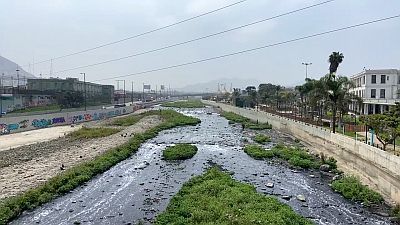 |
El Niño is a weather phenomenon, that has to do with the change of the Humboldt-stream in the Pacific. It happens very irregularly and varies much in strength. But the effect is, that the temperature change in the ocean makes the evaporation of the water change from west- to eastwards and so the rain falls in the Andes, where the warm air must rise, cool down and lose its water.
In Europe we fear that the warm waters of the Golf-stream might cool down. Then Northern Europe would be covered by ice again ...
|
In the meantime all the virtual participants of our tour are present and Vanessa starts walking. Through her gimble we see everything that she wants us to see.
While we cross the bridge in direction of the historic center, Vanessa explains that it was the conqueror Francisco Pizarro himself, who founded the modern city of Lima on the 18th of January 1535.
We enter the Jirón de la Unión, which after a short walk will lead us to the Plaza Mayor. But on the way we pass the Casa Aliaga, which is an original house built by Don Jerónimo de Aliaga, a fellow fighter of Pizarro. The latter rewarded him the area and Don Gerónimo became one of the first settlers in Lima. The Aliaga-family is living there since then, the 18th generation after Don Jerónimo. Today it is partly a museum. As we pass, listening to Vanessa's explanations, she points out the beautiful door. The entire building is - naturally - built in colonial style.
|
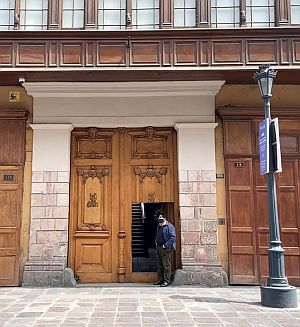 |
On the other side of the street we follow the western wing of the governmental palace, today, among others, seat of the President of Peru, but once belonging to Francisco Pizarro, who let it build as a palace for himself.
It are not only the monumental buildings, which impress me. It is also that the tours feel like being there, meeting people on the street, taking in all impressions from the surroundings, how people are dressed, which shops there are and much more. At the same time you have the guide pointing out the important sights and their history ...
|
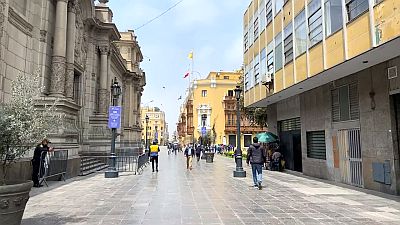 |
At the next corner we pass the Plaza Perú to the right and then the Plaza Mayor opens up to the left. Again it had been Pizarro, who had decided that this should be the main square of his city. Therefore he had built his palace with the main entrance looking to the square. It is so big, that one has to go to the center of the square, in order to capture its wings as well.
Already in November 1536 the Spaniards approved of the founding of the city and one year later still, Charles V, granted the city their Cote of Arms.
|
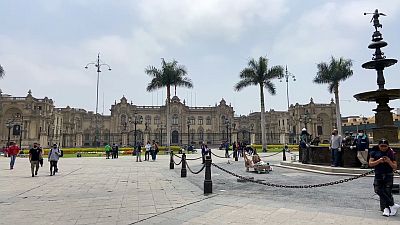 |
|
This Cote of Arms was granted by the Emperor, who included Spain into the Habsburg Empire, so that he really was the first, in who's empire the sun never set - may the English say, whatever they want. Besides Charles united the Habsburg's possessions in Austria and Spain, so that they had become the mightiest power in Europe. They won their lands mainly through marriages and not through wars. And even if they officially were the Emperors of the Holy Roman Empire, the Austrian line reigned for more than half a millennium.
|
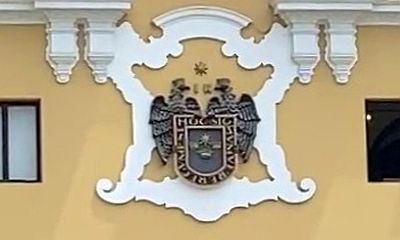 |
So, excuse us, World, in Austria we see that obliterated Roman Empire as Austrian Empire, before it became so offically in 1806.
Back to the Cote of Arms, found on the City Hall on the Plaza Mayor (see photo to the right), which has the two eagles (Austria and Spain) as symbol for the Habsburg Empire. The text says: "Signum vere regum est", which means about "This sign shows truly Royality". On top of the shield there are the letters I and K, which are the initials for Ioana (Joanna) of Castile and her son Karolus (Charles).
|
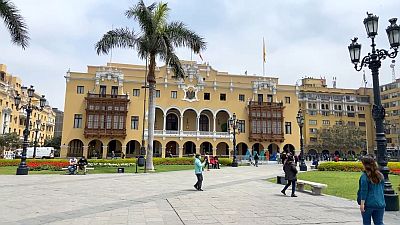 |
The third, eastern side of the big square is limited by the Cathedral of Lima. Pizarro himself laid the first stone in 1535 and his daughter Francesca donated five thousand goldpesos for the building, which was about a third of the total cost. Today's church is the third cathedral on this spot. In 1602 this last building, surviving until today, was started. The church is consegrated to the Apostle St. John.
Immediately to the left we find the Archbishop's residence. In spite of its colonial-style look, not at least because of the wooden balconies, it was erected only in 1924.
|
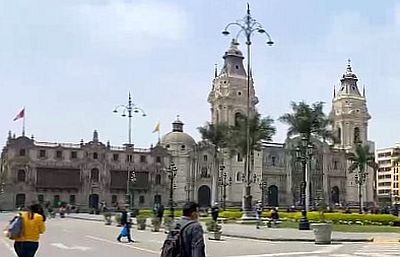 |
It is one of the most beautiful neo-colonial buildings in Lima. The original palace from 1535 was located somewhere else around the square.
On top of the palace, there are two flags - one is that of the Vatican and the other is the Peruvian. Our guide explains that the Peruvian flag contains the Cote of Arms in the white field, when officially used, but that ordinary flags are not allowed to carry it. Originally the flag had the symbol of the Sun - but that was removed by Simón Bolívar in 1825, four years after Peru became independent..
In the middle of the Plaza Mayor stands a fountain, built in 1651. On top, there is an angel, facing the presidential palace. Its popular name is the Angel of Fame.
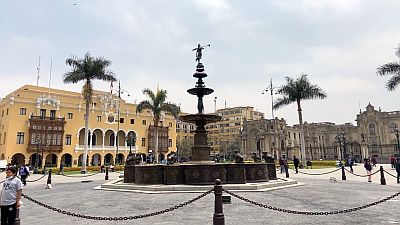
|
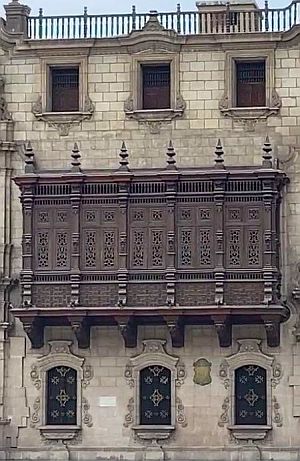 |
On the Plaza Mayor we turn around and follow the eastern side of the palace, the Jirón Carabaya. On our way we encounter a diverse shop in one of the old, original buildings. The owner allows us to enter (actually it is only our guide, Vanessa, who needs to enter) in order to see the patio of the house, so that we can imagine its height.
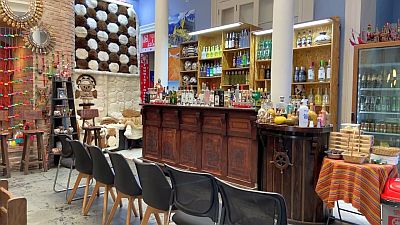
|
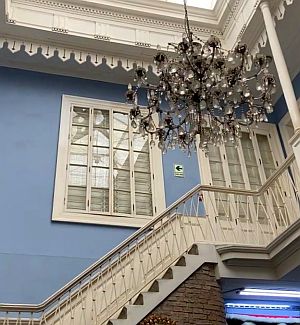 |
Under the staircase in the right picture above, you can see the top of the mirror from the left corner of the left picture. This will help you imagine the real hight of the patio.
We are still following the wing of the palace, until the street comes to an end, where we find the "Casa de la Literatura Peruviana" or the "House of Peruvian Literature". To enter it might be another adventure, but Vanessa's guiding ends here, just a good hundred metres from the Puente de Piedra, where we started this tour.
|
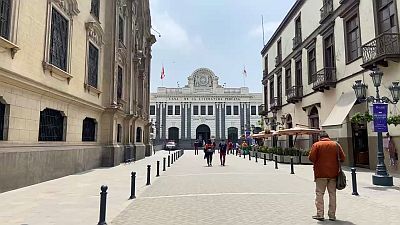 |
Copyright Bernhard Kauntz, Västerås 2022
Back to  or to the or to the  of of 
last update: 27.9.2022 by webmaster@werbeka.com
|

